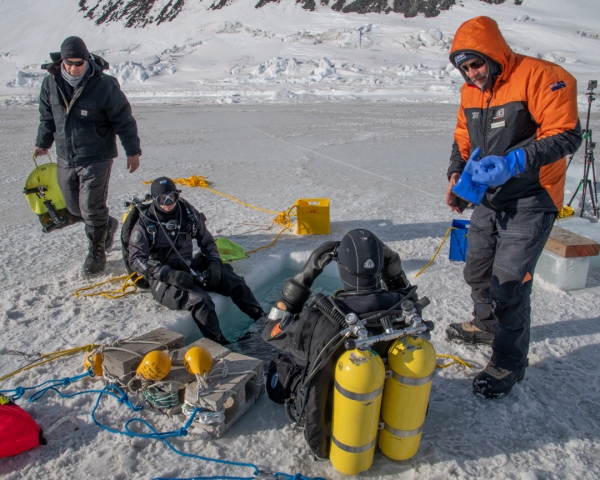The rich diversity of marine life near Scott Base in Antarctica has stunned scientists diving under the ice to set up environmental monitoring sites.
Five of NIWA’s specialist divers, working on behalf of Antarctica New Zealand, have recently been setting up three sites to monitor the coastal marine environment and assess tidal currents.
Using diver held cameras as well as remotely operated vehicles, they established transects that will enable them to check how these animal communities change over time.
Project leader Dr Drew Lohrer said the aim of the trip was to establish sites in the marine environment close to Scott Base that could be sampled repeatedly over the next few years as the Scott Base rebuild progresses.
“We saw some amazing animals; the environment was dominated by organisms that stay in one place capturing material in the water. There were a lot of sponges, soft corals, and hydroids along with animals capable of motion such as echinoderms, bivalves, and sea spiders. The diversity of the sponges was the most astounding thing about this trip. Some of them were up to a metre wide.”
The team also set up some specialised equipment to provide information on the speed and direction of tidal currents near Scott Base. Called Acoustic Doppler Current Profilers (ADCPs), the instruments were deployed underwater at two sites on either side of Scott Base in November, and later melted out of the sea ice and retrieved by Antarctica New Zealand staff.
Diving under the ice in Antarctica is challenging and requires extra safety precautions such as tethers to help divers communicate with others up top. Divers also carry two air tanks and a back up regulator to make the operation safer.
“It is very cold and challenging and you’re wearing a lot of gear. But there is always the thrill of the sights you get to see and the almost unlimited visibility. The diverse life under the ice is quite astounding,” says specialist diver Peter Marriott.
The divers also saw anchor ice formations –plate-like ice crystals of ice that seed and grow on the bottom of the sea bed – in water so cold it enables ice to form blanketing crystalline structures in a nearshore environment.
This article forms part of our 2019 Summer Series. Read other stories in the series.
1 / 8

NIWA diver Dave Bremner just below the roof of the ice. [Peter Marriott]
2 / 8

Acoustic Doppler current profiler
3 / 8

NIWA divers Drew Lohrer and Leigh Tait above ground, melting a hole through the ice. [Peter Marriott]
4 / 8

5 / 8

NIWA divers Drew Lohrer and Leigh Tait above ground, melting a hole through the ice. [Peter Marriott]
6 / 8

7 / 8

Divers prepare for entry under the ice. [Peter Marriott]
8 / 8


